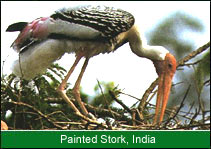 |
 |
 |
||
|
||||
Bird Watching India
Birdwatching is a way not only of learning about birds, but a channel for study of the natural world as a whole. The immense variety of birdlife
in the Oriental region, and the large size and colourful plumage of many species
makes it an especially attractive occupation. As you observe bird behaviour
you cannot fail to notice how the changing seasons affect plant and insect life
too.
channel for study of the natural world as a whole. The immense variety of birdlife
in the Oriental region, and the large size and colourful plumage of many species
makes it an especially attractive occupation. As you observe bird behaviour
you cannot fail to notice how the changing seasons affect plant and insect life
too.
Birdwatching is also simple for the beginner to take up as it requires no special equipment, although binoculars are a great help in identification.
To see birds most easily you should be quiet, careful and inconspicuous. It is best to wear subdued colours, to walk slowly and make use of cover such as banks, trees and bushes. It is often a good idea to take up position on the edge of a forest clearing or near a fruiting tree and let the birds come to you. Lakes and jheels are also good locations for observation. Carry a notebook so that you can jot down details of any bird you can't immediately identify and then check your descriptions against those in a guide.
This guide in particular is designed as an aid to field identification and aims to help everyone from the newest of enthusiasts to the habitual birdwatcher. We have drawn on the vast reserve of scholarship on sub-continental birdlife carried out by Salim Ali, Dillon Ripley and so many others.
Each bird description begins with the species number, followed by the common English name, the scientific name and size. Sizes of birds stated are approximate and general
ly taken from the tip of the bill to the end of the tail.
Then follows a description of the plumage of both male and female birds, along with any seasonal variations. We have also noted any behaviour which helps easy identification. The final entries list the bird's food, voice, range and habitat.
Common names of birds are often being revised. Readers will note that in certain cases birds have more than one name. We have given the names which are most commonly used in the sub-continent. However, to help readers who may be more familiar with other names a list of alternate names has been provided on pages 186-187.
Birdwatching is a way not only of learning about birds, but a
 channel for study of the natural world as a whole. The immense variety of birdlife
in the Oriental region, and the large size and colourful plumage of many species
makes it an especially attractive occupation. As you observe bird behaviour
you cannot fail to notice how the changing seasons affect plant and insect life
too.
channel for study of the natural world as a whole. The immense variety of birdlife
in the Oriental region, and the large size and colourful plumage of many species
makes it an especially attractive occupation. As you observe bird behaviour
you cannot fail to notice how the changing seasons affect plant and insect life
too.Birdwatching is also simple for the beginner to take up as it requires no special equipment, although binoculars are a great help in identification.
To see birds most easily you should be quiet, careful and inconspicuous. It is best to wear subdued colours, to walk slowly and make use of cover such as banks, trees and bushes. It is often a good idea to take up position on the edge of a forest clearing or near a fruiting tree and let the birds come to you. Lakes and jheels are also good locations for observation. Carry a notebook so that you can jot down details of any bird you can't immediately identify and then check your descriptions against those in a guide.
This guide in particular is designed as an aid to field identification and aims to help everyone from the newest of enthusiasts to the habitual birdwatcher. We have drawn on the vast reserve of scholarship on sub-continental birdlife carried out by Salim Ali, Dillon Ripley and so many others.

Each bird description begins with the species number, followed by the common English name, the scientific name and size. Sizes of birds stated are approximate and general
ly taken from the tip of the bill to the end of the tail.
Then follows a description of the plumage of both male and female birds, along with any seasonal variations. We have also noted any behaviour which helps easy identification. The final entries list the bird's food, voice, range and habitat.
Common names of birds are often being revised. Readers will note that in certain cases birds have more than one name. We have given the names which are most commonly used in the sub-continent. However, to help readers who may be more familiar with other names a list of alternate names has been provided on pages 186-187.
Indian Birding
Birding in India Birding Tours India
Birding Tours India  Bird Watching India
Bird Watching India  India Bird Checklist
India Bird Checklist  Habitat & Bird Species
Habitat & Bird Species
Bird Conservation
Birding in India
Bird Conservation
| Home | About Us | FAQ's | Contact Us | Commendations | Reservation |
| Copyright © Wildlife India Plus ( All Rights Reserved. ) | Web Development & SEO Services by |

